
|   |

|   |
 e-mail: leelakaverivenkat@gmail.com Showcasing Odissi and deliberating on its generational changes Photos: Vinay Tiwari June 20, 2024 The two day Omkara Festival at the IIC premises organised by Manasa-Art Without Frontiers (with focus on Seraikella Chhau and Odissi), during its animated seminar discussion, moderated competently by Sharon Lowen, put the searchlight on Parivartan, the very pertinent issue of generational changes. This has been an important concern for all traditions with roots in a deep cultural past, as they transit through time. How does an intangible cultural heritage, travelling out of its region to spaces all over the world, deal with the challenges of having to deal with practitioners from different language and religious backgrounds, while creating lebensraum for itself amidst the imperatives of catering to different cultural sensibilities? In India, hereditary Art traditions practiced by exclusive communities, sustained through ages by religious institutions and monarchy, faced with the compulsions of having to be repositioned as secular art for proscenium spaces, has had to adjust to cataclysmic changes. But in the case of Odissi which is a post-Independence development, the time frame one is looking at is somewhat different, for the Mahari was already withering, when with nationalism and a flourishing vibrant theatre, ideas of establishing the dance of Odisha with classical credentials, began to spread. And it was in Independent India of the fifties that teachers hailing from a theatre background like Gurus Pankaj Charan Das, Kelucharan Mohapatra and Debaprasad Das, in the famous Jayantika meetings starting in 1957, organized under the name of Odissi, a 'concert format' bringing under a standardized umbrella the individual creative efforts of the three Gurus reflecting influences of Mahari, of the Gotipua dances and the broadened inputs for abhinaya from artistes from Orissa trained in Kalakshetra like Guru Mayadhar Raut and Sanjukta Panigrahi. Sculptural representation of dance in temples also proved to be a significant inspiration. For Odissi, the parivartan, after being confined to the soil of its origin even during the late forties, saw its appearance on the Delhi stage in the 1950s leading to its fast spread to all parts of the globe with followers in many countries - all happening within the space of half a century! Inviting Kumkum Mohanty to talk of her experience over the last seventy years was a wise choice. One still has vivid memories of young Kumkum participating in rehearsals for blockbuster Odissi events held in her parents' home, with Guru Kelucharan Mohapatra presiding over the dance, working in close communion with Bhubaneswar Misra, the musical wizard, with Suren Mohanty (script writer) also present, and with significant inputs coming from the excellent musical brain of P.V. Krishnamurty (who as the Director of AIR Cuttack at the time made landmark contribution to both dance and music in Odisha) participating, seated with a harmonium - and Kumkum's mother supplying endless cups of tea to the participants! Trained under Kelucharan's baton in the fifties, when the Guru was working for the Kala Vikas Kendra in Cuttack, Kumkum's contribution as dancer and later as Chief Executive of the Odissi Research Centre, an autonomous body set up by the State Government in 1986 where Odissi history was created, working alongside the creative magic of the Guru Kelucharan Mohapatra / Bhubaneswar Misra combine, has been acknowledged as a golden chapter in Odissi. Kumkum's pioneering efforts in bringing out printed matter on the theoretical aspects of the Odissi technique and its grammar, specifying positions like Chauka, the Bhangis with accent on Tribhanga, Brahmaris, etc (particularly significant in a dance form which was largely existing in scattered expressions, till later combined into a prescribed form through the efforts of Gurus) apart from inaugurating events like the Konark festival, speak volumes for the role she played. Dilating confidently on the early history of the dance, Kumkum referred to items like Khela kheluni, Phulla bhramara, Pancha Pushpa (where Kumkum was Rathi and Sanjukta, Madana), Krishna Gatha, a major dance work written by Suren Mohanty and how PVK helped in the rehearsals. Kumkum's narrative, along with bits of her mimicry (at which she is a genius) thrown in, kept the listeners enthralled. "Wah! Wah!" reactions from the gathering greeted the mention of the special characteristic of Odissi music through the metaphor on the type of hair - (coined by P. V. Krishnamurty) - of Hindustani music as straight hair, hair with curls as representing Carnatic music while the in between wavy hair best defined the 'gamakas' of Odissi music. While stressing on the right Thani, Bhangis etc, and the need for dancers to master, along with the practice, the theoretical aspects, statements like "persons not able to hold audience attention even for a couple of hours have no right to dance", were neither here nor there. Instead, given the years of closeness she had enjoyed with Bhubaneswar Misra and Guru Kelucharan Mohapatra, watching the togetherness of dance choreographed to reflect the mood of the music in a classical mode, she could have made observations on the changing (parivartan) dance/music relationship. Bhubaneswar Misra's music was strictly raga based music, whereas now ragas are often created on the basis of reading old musical texts (ragas actually emerge through usage, with years of musical imagination going into the character of a raga), and with challenging themes like Make in Odisha also being tried through Odissi technique, wordy background explanations and different tunes and sounds trying to capture a mood, the nature of music for dance is changing in the non margam presentations. Have teaching methods changed and if so in what way? But for Kumkum representing the old school, the relationship of dance trying to accommodate contemporary sensibilities, did not seem relevant. 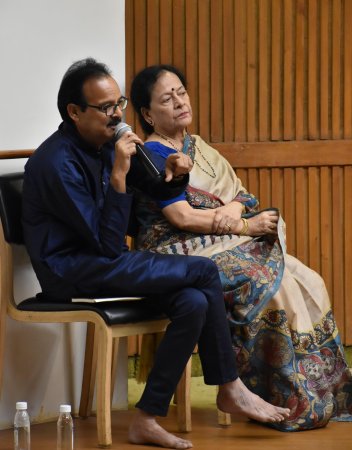 Sunil Dubey, Kumkum Mohanty It was very informative listening to Seraikella Chhau concerns voiced by Sunil Dubey, brother of Late Gopal Dubey of Trinetra. One felt sorry for these artistes and how a band of dedicated performers, with very little support from the government, had managed to keep the art form alive. In a long history of litanies, the recognition as the Ninth Classical Dance awarded to Seraikella Chhau (the first I have heard of it) had, understandably come as a deep source of joy and encouragement. The demonstration by Upendra Biswal on the special percussion instrument, the dhol, the mainstay of Chhau and nagara, a kettle drum, and the manner in which the dance had incorporated classical norms in its tala structure, wherein Hindustani talas like Dhamar and Roopak were adapted to the percussion, with a different language of rhythmic syllables, was demonstrated. He also referred to the music which was based on classical ragas (Bhairav Thaat) and the Parikhanda movements, used along with the mask, which is a very important aspect of Seraikella Chhau. Some bhangis were also mentioned. Considering the step motherly treatment Seraikella Chhau has received from the Ministry of Culture, particularly after the passing away of Gopal Dubey, one is happy about this gesture of classical recognition by the government. Aware of the lesser status accorded to forms other than classical, in terms of remuneration for performances and the kind of treatment the performers receive in general, on foreign travels, accommodated in very mediocre hotels, the 'classical' recognition assumes a very important place in the overall scheme of things. But one is unable to understand how the cultural powers that be, make decisions - when Seraikella Chhau gets the classical status, and Mayurbhanj Chhau (where maximum exploration has seen the form being used very successfully for innumerable dance productions on a variety of themes, often in preference to classical forms) does not! 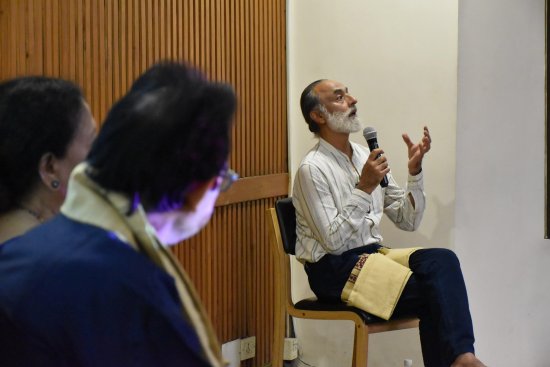 Navtej Johar If Kumkum represented the euphoria associated with Odissi emerging in all its new glory, the voice of ennui at the 'packaged' nature of classical dances was expressed by Navtej Johar with his combined Bharatanatyam / Contemporary Dance background. Starting the seminar discussions after Sharon Lowen's pertinent opening observations, he came to the central point straight away. "The body betrays that which is not allowed to be said," said Navtej Johar, who, while growing up, was hooked up on music, treated to the voices of Rasoolan Bai, Begum Akhtar, and songs of Nanak, Kabir, Mirabai. Bharatanatyam with its musicality became a possibility when he came under the spell of the Kalakshetra ambience. But gradually, disappointment took over and in his nagging discomfort at what he was seeing and feeling, he began to perceive that while 'the body was moving so hard, there was no movement'. Everything was becoming a 'show' and the inside of the dancer was not speaking through the art form. It was too much form with nothing being said. It is pertinent to ask, in the midst of all these changes, why classical dance is being labeled for acquiring a 'packaged look', while music, even while based on compositions common to all singers, has escaped similar criticism. Is it because of the teaching process, or is it because the body as the instrument of dance, gets more subjected to, and influenced by societal attitudes (let us not forget that the history of Bharatanatyam got written on the body of the hereditary dancer)? But Navtej says it is not the body as instrument, but the manner in which society has begun to treat dance like an ornament of glamour, that the art form has lost its focus as a statement of intent, being reduced to false glamour and glitter. Sachhayi (truth) is disappearing. The teacher teaches the language - but thereafter how and what the dancer says through that language is what counts - a point all agreed on. That the seminar effort gave voice to several viewpoints is important. Such animated discussions are not a frequent occurrence in dance, and need to take place more often. The evening performances for which the curtain raiser was provided by Sharon Lowen's students, began with a Padma Patra Mangalacharan in Odissi, as invocation paying homage to Vishnu, the consort of the lotus eyed Lakshmi, who as the very embodiment of peace, is visualized in his form as Padmanabha, reclining on the serpent couch, as described in the hymn 'Shantakaram Bhujagashayanam Padmanabham Suresham'. Set to raag Bairagi and Ektali, and ending with Trikhandi Pranam to the God, the Guru and the distinguished audience, the involved rendition by dancers Pragya Ghosh, Nitisha Nanda, Vishwanath Mangaraj and Perrine Legoullon, did full justice to their Guru Sharon Lowen's group choreography, heralding a memorable start for the festival. It is not often that Seraikella Chhau is presented in festivals. Trinetra Chhau Dance Centre's presentations of Seraikella Chhau brought out that subtle mix of body movement reflecting the martial vigor (from the Parikhanda body movement), alongside the poetic appeal of the dancer's face covered in delicate masks of great aesthetic appeal. There is a mask for every character, and it was heartening to see the dancers performing with a fine sense of balance, sans the slight unsteadiness which often results from the visibility span being hampered by the masks worn by the performers. 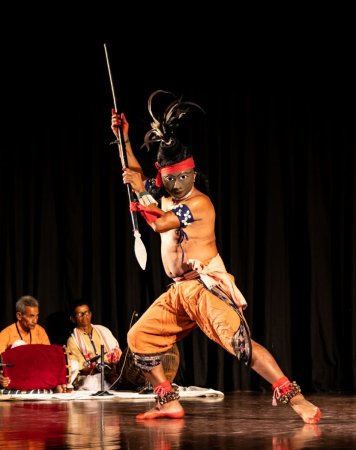 Seraikella Chhau Starting with Hara Parvati, the colourful Peacock Dance was rendered next as a solo by Bijay Sardar, set to raag Megh and taal Keherwa. Barsa Jham Jham in teentaal and raga Megh saw Anjali Desai and Pradeep Kabi as the sringar couple finding solace in each other's arms in the darkness of a cloudy night with intermittent rain showers, cloudburst and thunder. The classic Hunter Dance by Nibaran Mahato had all the sly, careful tread of the hunter in search of prey. Based on a legend associated with Konark Sun temple, the tragic love story of maiden Chandrabhaga who plunges into the depth of the ocean to escape the unwanted embrace of Surya had Sudeep and Pradeep Kabi as performers - the music based on the melody of an Odissi Chhand of Kavi Surya Granthaval in teental. The musical team whose performance sets the tone for each item in this dance, had Sunil Dubey leading on harmonium with Deoraj Dubey on the flute, Binod Pradhan on dhol and Baburam Sardar on the nagara. It is to the credit of the team that they have retained good costume sense, and their dancers are well trained. 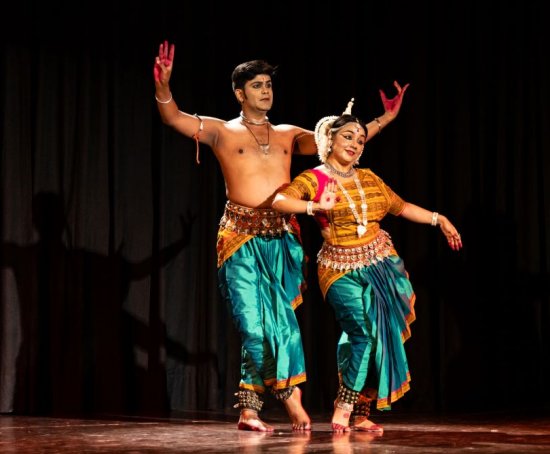 Ranjana Gauhar's disciples Ranjana Gauhar's principal students Vinod Kevin Bachan, Vrinda Chadha and Urjaswi Dutta took the floor with Ardhanariswara, based on lines from Kalidasa's Raghuvamsham bringing out the complimenting contrasts of the Shiva / Sakti divinity - His ash covered body, dark tresses and matted locks against her Champa flowered complexion with black hair in a bun adorned with pearls. The ragamalika music composed by Bankim Sethi with Ranjana Gauhar's choreography has been performed by these dancers on several occasions. Technically correct, given the advantages of Kevin's stage presence against Vrinda's Chadha's grace, the presentation, for this critic, was mechanical, wanting in that final point of deeper involvement. The same trio presented the Pallavi in Shankarabharanam, the choreography by Ranjana's guru Mayadhar Raut based on the music composed by Harihar Panda. Their Guru Ranjana Gauhar's rendition of the ashtapadi Rati Sukha Sare showing the sakhi urging Radha to join Krishna, awaiting her arrival eagerly on the Jamuna banks, had an interesting aftermath in that the next day, a male dancer presented the very same ashtapadi. For many in the audience, it underlined how the total merging of the dancer in the character of the protagonist in the composition, in this case the ashtapadi, can obliterate, for the audience, dancer's gender and persona - which is what, making the dance one's own inner statement is all about - making dance, the dancer. 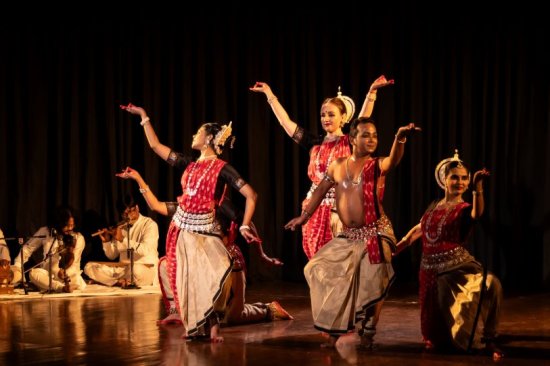 Sharon Lowen's disciples By far the most impressive performances in this festival came from Sharon Lowen's disciples. And what a balanced batch of musicians they had with a wonderful combination comprising Sukant Kumar Nayak and Ashish Nayak's vocal support, Prafulla Mangaraj's subtlety on mardala, and the very versatile Agnimitra Behera on violin along with Srinibas Satpathy on flute. Taking the stage for the first half of the evening on the last day, the performance began with yet another involved Mangalacharan rendition, this time dedicated to the iconographic images of Shiva based on lines from Tulsidas and composed by V. Sarala Rao. Set to raga Bhatiyar and Jhampa tala, dancers Vishwanath Mangaraj, Nitisha Nanda, Pragya Ghosh, Aashi Kumar and Perrine Legoullon moved with supreme grace and precision - and more than anything else, with a deep sense of the individual dancers communicating their innermost thoughts through the language of the dance. The Taranga Pallavi by the same group of performers, created an incredibly moving impression - the rich melody of raga Bilahari as only Bhubaneswar Misra could have conceived, rendered in perfect symphony by the musicians with the total in-communion, mesmerizing movements of Kelubabu's dance choreography, transporting the audience to another space. That there has never been another Bhubaneswar Misra is a tragedy. Watching this Pallavi, one felt that all the talk about the 'same old', or new themes in dance, is of little concern - when the real strength of conviction lies in the dance reflecting the dancer's inner core - where movement speaks and is not just an outward decoration. 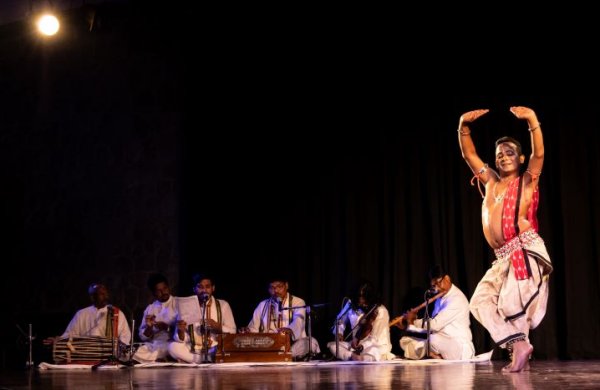 Vishwanath Mangaraj Presenting the same ashtapadi Dhira Samire as Ranjana Gauhar was Vishwanath Mangaraj, certainly the most sensitive of male dancers in Odissi today. Proving how the dancer's gender is of no concern for the performer, totally absorbed in the moment of the dance one is presenting, the dancer here became the Sakhi in an earnest exchange with Radha. Going into a detailed description of how Krishna waits on the banks of the Jamuna, pining for her, with even his flute seeming to call out her name, he describes how "Krishna's eyes look for your step, even in the slightest leaf stir or a falling feather - and preparing a bed of flowers, he awaits you. Remove your telltale anklets and secretly go and join him." Rendered to music in raga Kalyan set to Ektali, the dancer's persuasive abhinaya proves how this young dancer is maturing. 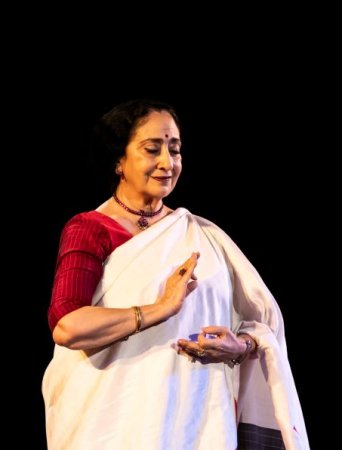 Sharon Lowen After the presentation of the Moksha finale set to raga Bhairavi by the dancers of Manasa -Art Without Frontiers dancers, the closing moments were ushered through Balamurali Krishna's Omkarakarini in raga Lavanya on the complete destruction of the ego and merging with the sacred form of OM - as Sharon Lowen emerging from behind the wings to stand in the centre in a slow, reverential salutation, rang in that final moment of total silence and communion with space and the cosmos. Rightfully the last section of the festival was for its chief and senior most participant Kumkum Mohanty and her troupe. For her troupe while Agnimitra Behera on violin and Srinibas Satpathy on flute remained, the singer was Harapriya Swain and mardal was played by Murlidhara Swain. Sadly, for this critic, the students fell far short of reflecting their training under a person who has played such a major role in the creation of Odissi. 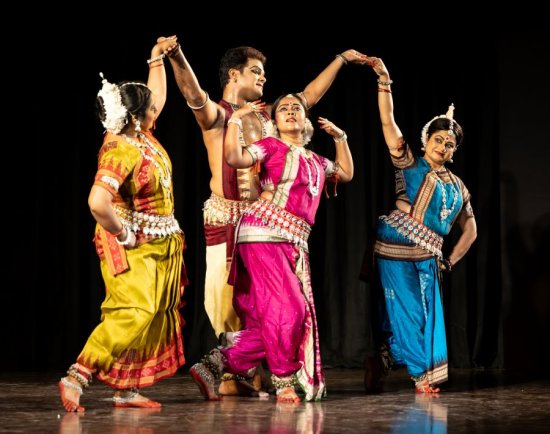 Kumkum Mohanty's disciples Still young and with a name to protect, Lucky Mohanty owes it to himself to take charge of his wellness and be aware of the importance of dance aesthetics. The female dancers Swetaleena Pattnaik, Lopamudra Nayak and Anish Anukampa too have some way to go, before they acquire the smooth grace Odissi is known for and before they can bring out the lyricism of pure dance, in Kumkum's newly choreographed Kirwani Pallavi. The abhinaya in the Gopal Krishna lyric Shyama ku juhar, with the music composed by flautist Nityananda Mohapatra set to raga Misra Kafi and taal Khemta, wherein Radha addressing Krishna bemoans her fate, on hearing gossip in the village about his dalliance with Chandrabali, which had its moments, needed more conviction of felt emotions. Despite the years, one could enjoy glimpses of the old Kumkum in the abhinaya for Yagnaseni for which late Prafulla Kar's music has choreography by the legendary Kelucharan Mohapatra. Based on Pratibha Ray's novel of the same title, the extract selected, in its high literary content in Odiya language, needed explanation. With an out-of-depth student compere, whose lack of familiarity with the dance and names associated with it had been all too clear throughout, to even imagine her to rise to the demands of explaining this item, was expecting the impossible. Kumkum with all her expertise should have started with a two minute explanation herself, of this soliloquy by Draupadi who is being tested for her fidelity, by having to spend over five consecutive nights, one night with each of her five husbands, remaining physically untouched while catering to their different characters. It is a very touching bit of literature - wherein Draupadi exposes her reactions. 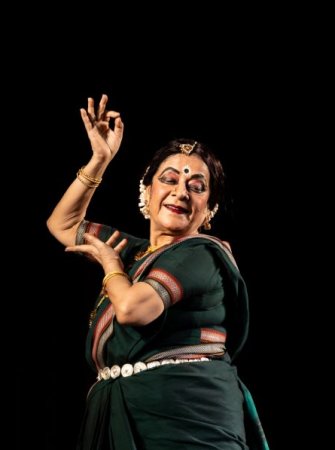 Kumkum Mohanty Not being touched by Yudhisthira mattered little - for he committed the ultimate sin of using her as pawn in a game of dice, with the horrendous consequence of her being disrobed in the Kaurava court with no husband coming to her rescue, till Krishna came to her help. She did not physically covet Bhima with the all-male / muscle strength. In staying untouched, the real test comes in the case of Arjuna who she loves with all her heart - and who had won her through a contest. Just because somebody, without even seeing her, says the prize won needs to be shared, did it mean that she should be made to serve five husbands? She wonders at the justice of this. Not being touched by Nakula and Sahadeva, adept at horse riding and chariot racing is also no strain. Kumkum in a simple saree getup, gave a rendition full of feeling. Sharon Lowen's Manasa-Art Without Frontiers deserves to be congratulated for the well thought out event.  Writing on the dance scene for the last forty years, Leela Venkataraman's incisive comments on performances of all dance forms, participation in dance discussions both in India and abroad, and as a regular contributor to Hindu Friday Review, journals like Sruti and Nartanam, makes her voice respected for its balanced critiquing. She is the author of several books like Indian Classical dance: Tradition in Transition, Classical Dance in India and Indian Classical dance: The Renaissance and Beyond. Post your comments Pl provide your name and email id along with your comment. All appropriate comments posted with name and email id in the blog will also be featured in the site. |